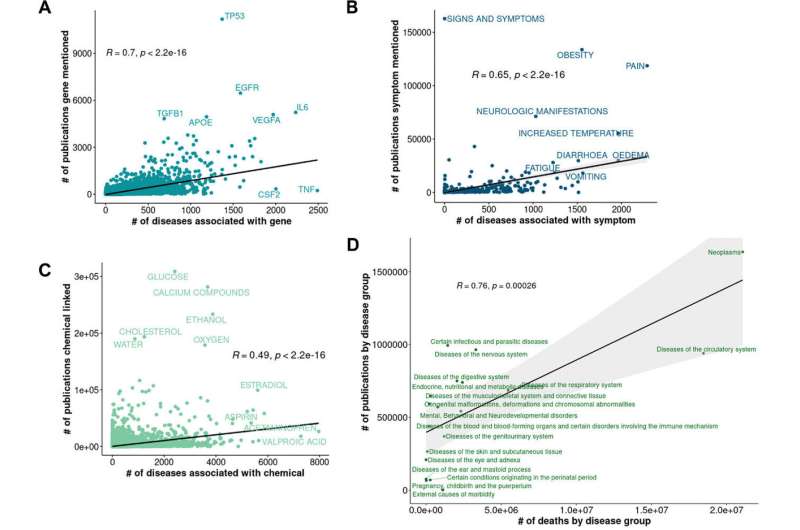This article has been reviewed according to Science X's editorial process and policies. Editors have highlighted the following attributes while ensuring the content's credibility:
fact-checked
peer-reviewed publication
trusted source
proofread
New study proposes multi-dimensional disease mapping for enhanced drug development

Tampere University researchers developed a method to map mechanistic connections between diseases, revealing deeper associations beyond traditional classifications based on affected organs and symptoms. This multi-dimensional approach presents a paradigm shift in disease classification and drug discovery, potentially leading to more personalized and effective medical treatments.
A recent study by the Finnish Hub for Development and Validation of Integrated Approaches (FHAIVE) introduces a novel approach to understanding human diseases by mapping their relationships using a multi-dimensional framework. The article "A Multi-Dimensional Approach to Map Disease Relationships Challenges Classical Disease Views" was published in Advanced Science on 5 June 2024.
Traditionally, diseases are categorized based on affected organs and observable symptoms, but this new method integrates genomic, chemical, and clinical data to reveal deeper mechanistic connections. This endeavor confirmed known associations between inflammatory and cardiometabolic conditions and further underscores their link to neurodegenerative disorders such as Alzheimer's disease.
The study was carried out in Professor Dario Greco's ERC project ARCHIMEDES, which aims to make chemicals and drugs safe for consumers and reduce animal testing in the experiments. The study was led by Dr. Lena Möbus. Co-authors were Angela Serra, Michele Fratello, Alisa Pavel and Antonio Federico.
The researchers utilized data from six data dimensions: disease-associated genes, pathways, symptoms, drugs, chemicals targeting genes, and chemicals medicating diseases. This comprehensive analysis of 502 diseases highlights significant distinctions from the classical International Classification of Diseases (ICD) system, suggesting the need for an updated classification that incorporates these mechanistic insights.
Using this multi-dimensional approach, the authors found that psoriasis, which manifests primarily in the skin, is closely related to inflammatory bowel disease (IBD), affecting the gut.
"Although a link between these diseases has been known before, it is interesting that a completely data-driven approach can recapitulate this relationship. Similarly, the disease map suggests a strong link between type 2 diabetes, a metabolic disease, and Alzheimer's disease, a degenerative brain condition. These close relationships are not easily explained by anatomical proximity, indicating deeper underlying connections," Möbus says.
Towards more personalized medical treatments
The study also found a strong correlation between the number of publications on a gene and the number of associated diseases for that gene. A similar correlation was found for symptoms. This suggests that the more a gene or symptom is studied, the more diseases it is linked to, driven by the overall disease burden indicated by mortality rates.
To account for the varying data richness for different diseases, the team implemented multiple strategies, such as using a consensus of different methods to quantify the relationships among diseases as well as integrating various data layers.
The research identified distinct clusters of cancerous and non-cancerous diseases. Within the cancerous clusters, the study observed groupings based on the cellular origin of the cancers rather than the organ where they manifest.
Carcinomas, which arise from the epithelial linings of organs, were clearly distinguished from sarcomas, which arise from soft tissues. This mechanistic clustering could help in understanding complex disease interactions and developing more targeted therapies.
Overall, this multi-dimensional mapping of diseases presents a potential paradigm shift in disease classification and drug discovery.
"By integrating diverse data sources, this approach offers a more nuanced understanding of disease relationships, which could enhance the development of effective drugs and address the growing challenge of multimorbidity. This data-driven perspective may benefit future research and clinical trials, and thus pave the way for more personalized and effective medical treatments," Möbus states.
More information: Lena Möbus et al, A Multi‐Dimensional Approach to Map Disease Relationships Challenges Classical Disease Views, Advanced Science (2024). DOI: 10.1002/advs.202401754




















